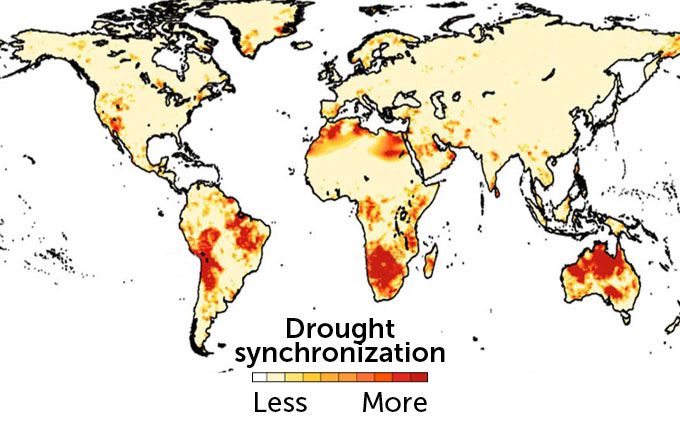This post was originally published on this site
Large-scale climate patterns that can impact weather across thousands of kilometers may have a hand in synchronizing multicontinental droughts and stoking wildfires around the world, two new studies find.
These profound patterns, known as climate teleconnections, typically occur as recurring phases that can last from weeks to years. “They are a kind of complex butterfly effect, in that things that are occurring in one place have many derivatives very far away,” says Sergio de Miguel, an ecosystem scientist at Spain’s University of Lleida and the Joint Research Unit CTFC-Agrotecnio in Solsona, Spain.
Major droughts arise around the same time at drought hot spots around the world, and the world’s major climate teleconnections may be behind the synchronization, researchers report in one study. What’s more, these profound patterns may also regulate the scorching of more than half of the area burned on Earth each year, de Miguel and colleagues report in the other study.
The research could help countries around the world forecast and collaborate to deal with widespread drought and fires, researchers say.
The El Niño-Southern Oscillation, or ENSO, is perhaps the most well-known climate teleconnection (SN: 8/21/19). ENSO entails phases during which weakened trade winds cause warm surface waters to amass in the eastern tropical Pacific Ocean, known as El Niño, and opposite phases of cooler tropical waters called La Niña.
These phases influence wind, temperature and precipitation patterns around the world, says climate scientist Samantha Stevenson of the University of California, Santa Barbara, who was not involved in either study. “If you change the temperature of the ocean in the tropical Pacific or the Atlantic … that energy has to go someplace,” she explains. For instance, a 1982 El Niño caused severe droughts in Indonesia and Australia and deluges and floods in parts of the United States.
Past research has predicted that human-caused climate change will provoke more intense droughts and worsen wildfire seasons in many regions (SN: 3/4/20). But few studies have investigated how shorter-lived climate variations — teleconnections — influence these events on a global scale. Such work could help countries improve forecasting efforts and share resources, says climate scientist Ashok Mishra of Clemson University in South Carolina.
In one of the new studies, Mishra and his colleagues tapped data on drought conditions from 1901 to 2018. They used a computer to simulate the world’s drought history as a network of drought events, drawing connections between events that occurred within three months of each other.
The researchers identified major drought hot spots across the globe — places in which droughts tended to appear simultaneously or within just a few months. These hot spots included the western and midwestern United States, the Amazon, the eastern slope of the Andes, South Africa, the Arabian deserts, southern Europe and Scandinavia.
“When you get a drought in one, you get a drought in others,” says climate scientist Ben Kravitz of Indiana University Bloomington, who was not involved in the study. “If that’s happening all at once, it can affect things like global trade, [distribution of humanitarian] aid, pollution and numerous other factors.”
A subsequent analysis of sea surface temperatures and precipitation patterns suggested that major climate teleconnections were behind the synchronization of droughts on separate continents, the researchers report January 10 in Nature Communications. El Niño appeared to be the main driver of simultaneous droughts spanning parts of South America, Africa and Australia. ENSO is known to exert a widespread influence on precipitation patterns (SN: 4/16/20). So that finding is “a good validation of the method,” Kravitz says. “We would expect that to appear.”
In the second study, published January 27 in Nature Communications, de Miguel and his colleagues investigated how climate teleconnections influence the amount of land burned around the world. Researchers knew that the climate patterns can influence the frequency and intensity of wildfires. In the new study, the researchers compared satellite data on global burned area from 1982 to 2018 with data on the strength and phase of the globe’s major climate teleconnections.
Variations in the yearly pattern of burned area strongly aligned with the phases and range of climate teleconnections. In all, these climate patterns regulate about 53 percent of the land burned worldwide each year, the team found. According to de Miguel, teleconnections directly influence the growth of vegetation and other conditions such as aridity, soil moisture and temperature that prime landscapes for fires.
The Tropical North Atlantic teleconnection, a pattern of shifting sea surface temperatures just north of the equator in the Atlantic Ocean, was associated with about one-quarter of the global burned area — making it the most powerful driver of global burning, especially in the Northern Hemisphere.
These researchers are showing that wildfire scars around the world are connected to these climate teleconnections, and that’s very useful, Stevenson says. “Studies like this can help us prepare how we might go about constructing larger scale international plans to deal with events that affect multiple places at once.”

